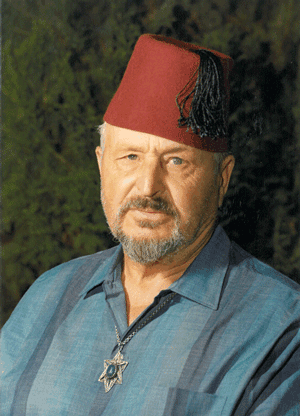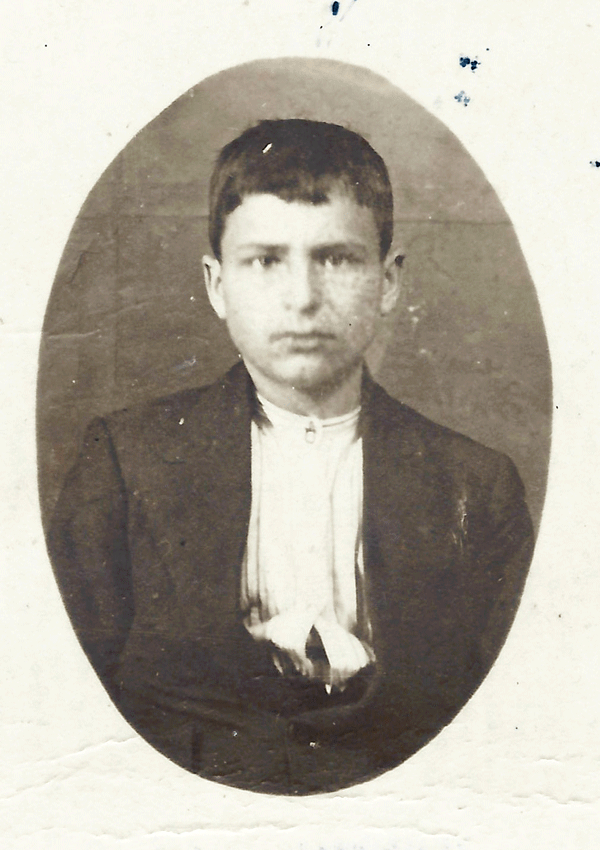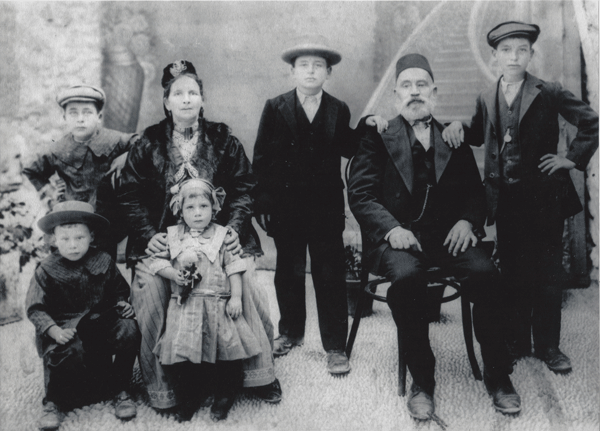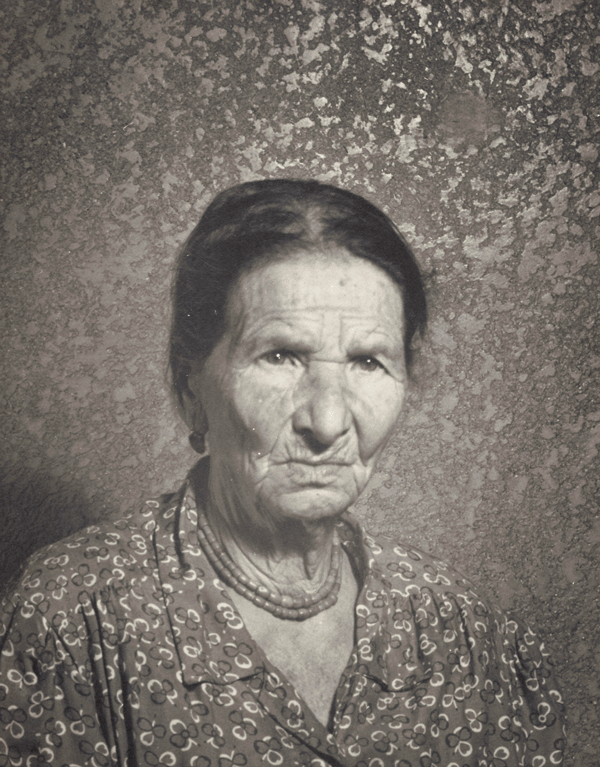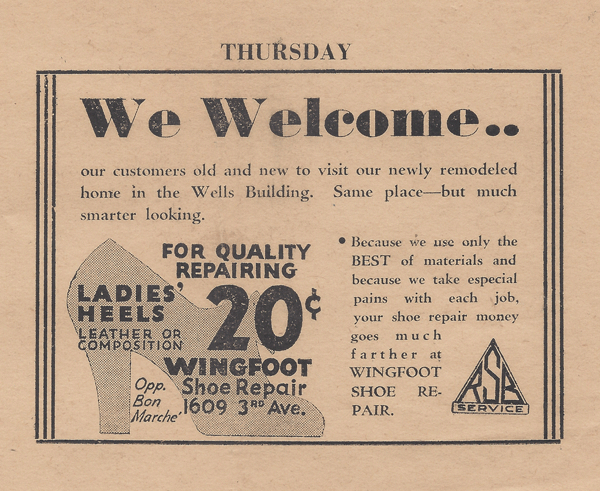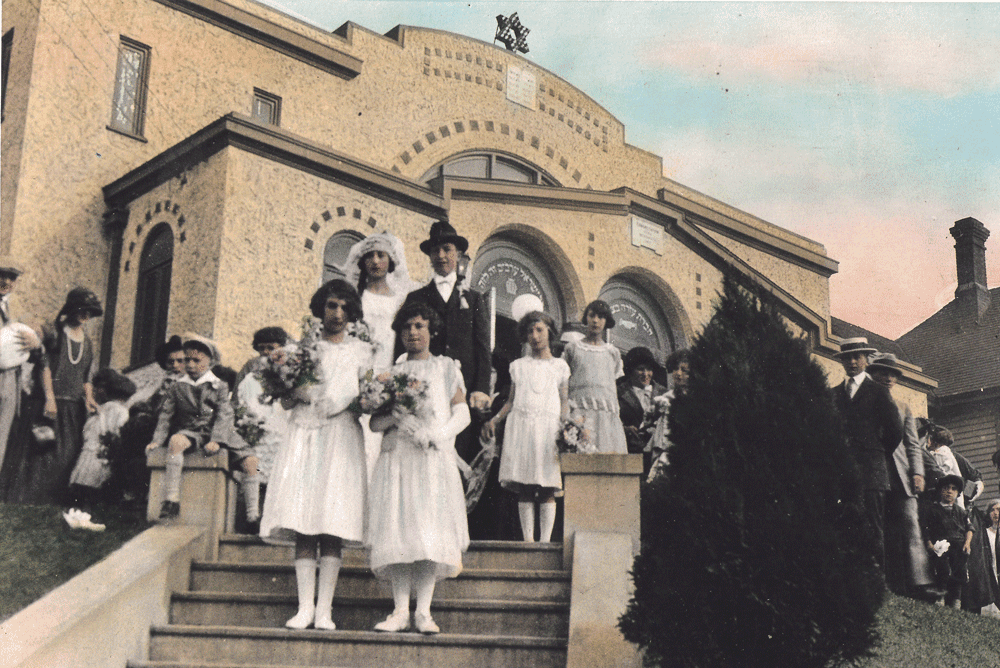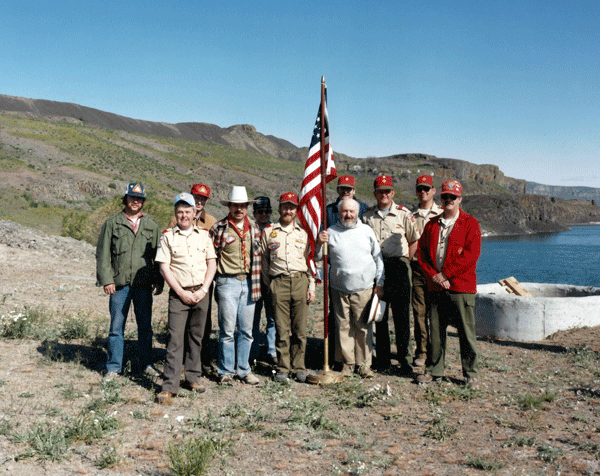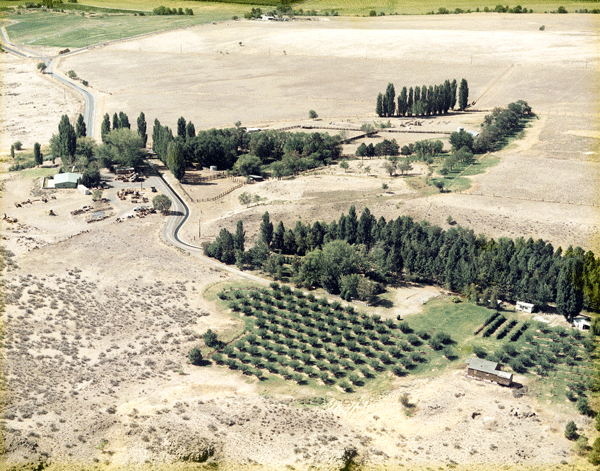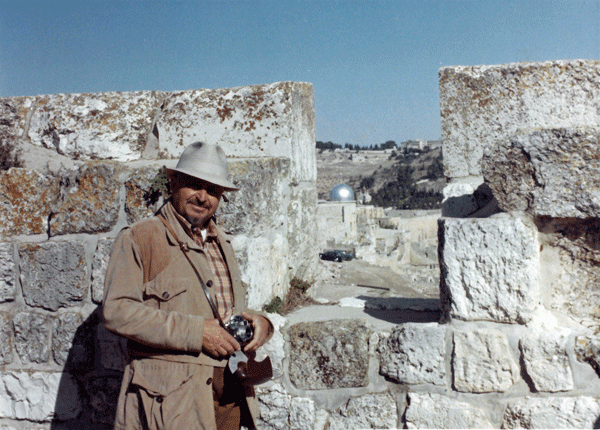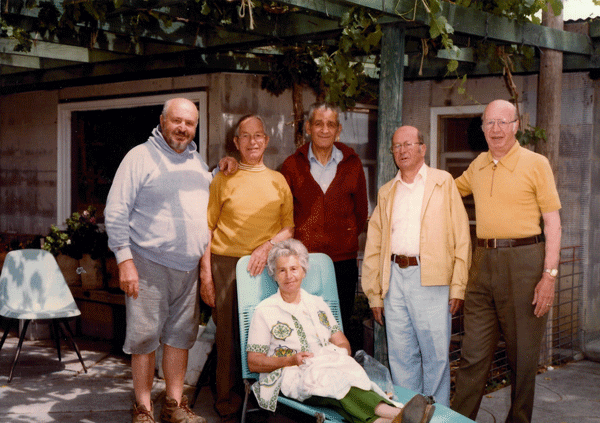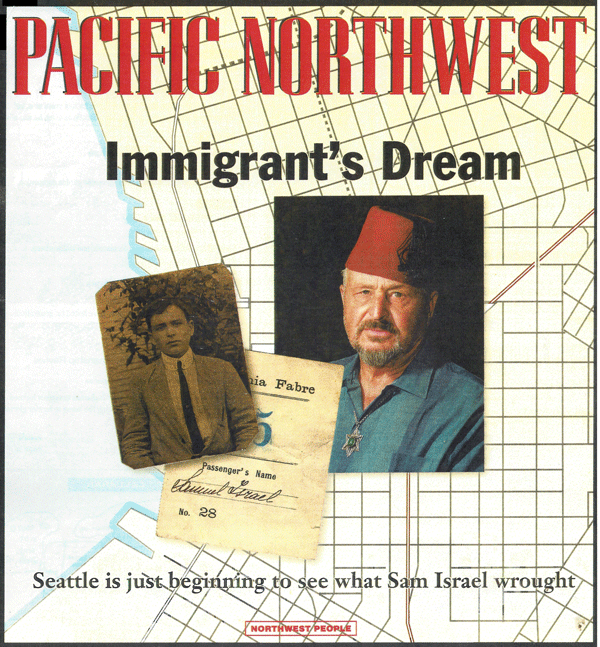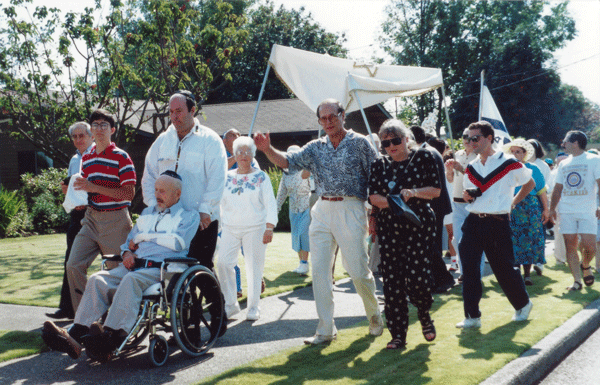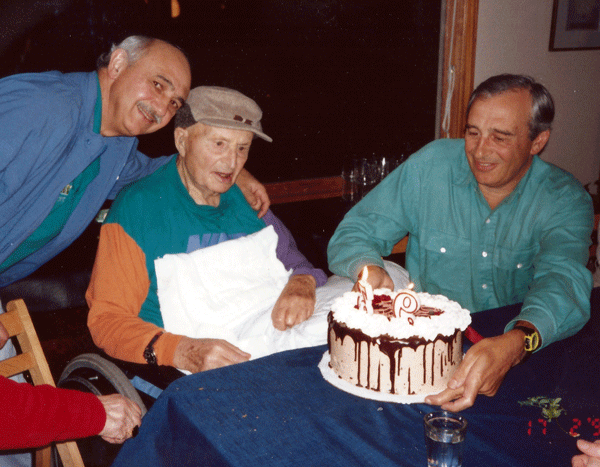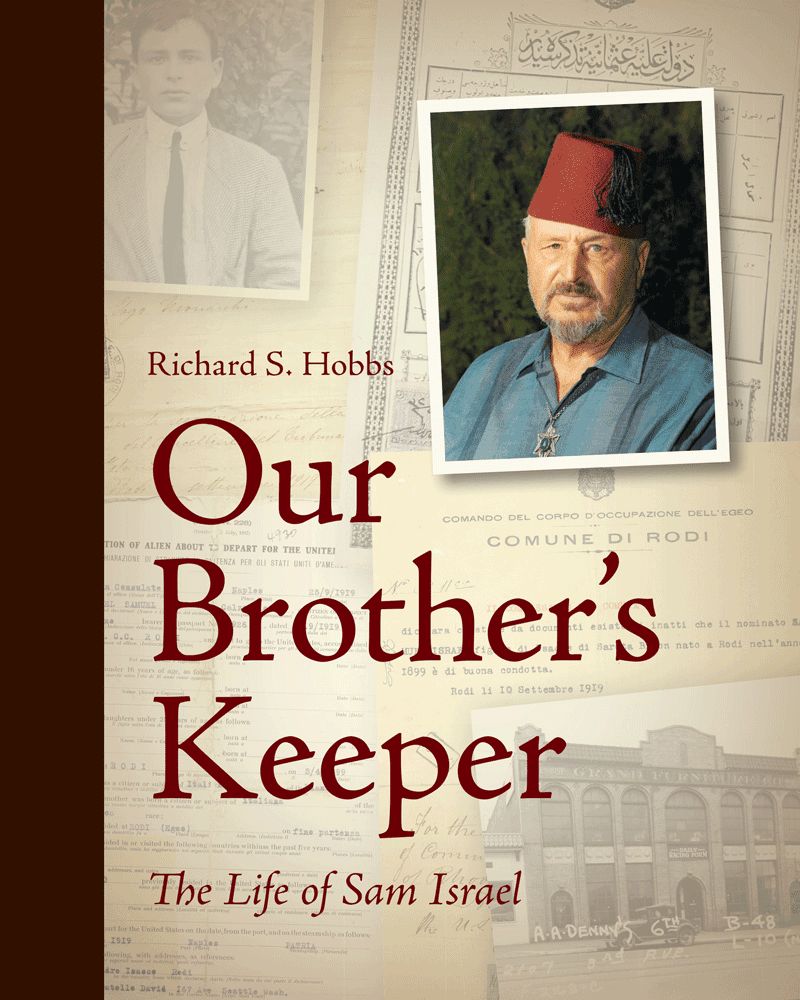Life and Legacy
-
Introduction
Sam Israel (b.1899) was one of the Pacific Northwest’s most eccentric, controversial, and enigmatic characters. An immigrant Sephardic Jewish shoemaker of humble beginnings, Israel arrived in Seattle in 1919 and thanks to savvy investing, came to own hundreds of properties in Seattle and around the state. This impressive assemblage included dozens of buildings in downtown Seattle and thousands of acres in Western and Eastern Washington valued at the time of his death in 1994 at more than $40 million. By focusing on basic maintenance instead of redevelopment and by keeping rents low, he became a key part of historic preservation and the growth of the arts community in Pioneer Square.
-
Sam Israel wearing the fez, harking back to his childhood on Rhodes, c. 1980
Always a challenging and independent-minded person, when he moved to Central Washington in 1960, his reputation as a reclusive absentee landlord grew. To his immediate family he was the revered “Uncle Sam”, but to others he remained a mystery.
Those close to him know about Sam Israel’s lifelong love of the outdoors and photography, his devotion to Jewish faith and history, and his generous support of numerous community organizations, from the Seattle Hebrew Academy to Boy Scouts and various wildlife and archaeological organizations in the United States and the State of Israel. He carried his faith in G-d, his Jewish identity, and a sense of personal responsibility for Jews and non-Jews from his home to the community and across the world. Sam never married, and upon his death in 1994 his properties were transferred to the foundation he established, and his fortune was dedicated to fund Jewish education in Washington State and other causes in Israel for the benefit of future generations. Today, the Samis Foundation carries on Sam Israel’s legacy, living and funding the heart of Sam’s motto: “We are our brother’s keeper.”
-
Biographical Highlights
Sam was born and grew up on the Island of Rhodes. He spent his youth in the Jewish quarter, the densely populated area located in the eastern section of the walled “Old City” built by the Knights of St. John and known as “la Juderia.” It remained a virtual Medieval town, noted for its intricate labyrinth of narrow, winding cobblestone streets and alleys, overhanging balconies, and tents and canopies that shaded commercial areas where merchants showed their wares. Among the network of twisting alleys and busy commercial streets were traditional fountains, Byzantine and medieval Gothic churches, mosques, picturesque shops, homes, and other buildings decorated with oriental motifs. Most dwellings, including the Israel family home, were whitewashed mud brick structures.
-
Sam; the photo appears on his “Declaration of Alien About to Depart for the United States,” September 25, 2019
-
Israel family portrait, in Rhodes, 1915 (click for details)
-
Sam grew up in a family whose life was an integral part of their community, distinguished by Sephardic religious practices, traditions, customs, and language. Their culture—an ancient and rich tapestry unique to the island, developed over the centuries after the 1492 Jewish expulsions from Spain birthed the Sepharad diaspora—was an intrinsic part of daily life, instilled by parents in their children as it had been for generations. The language of the Israel home and other Rhodeslis was Ladino, the Judeo-Spanish language rooted in a fifteenth-century Castilian dialect and flavored with multiple cultural influences from the Eastern Mediterranean, reflected in Hebrew, Portuguese, Greek, Arabic, Italian, and Turkish words and expressions. In the cosmopolitan community of Rhodes, Sam Israel became fluent in four languages--his native Ladino, as well as Italian, Greek, and Turkish—and he even learned a little French. From about 1906 to 1912, Sam attended the Alliance Israélite Universelle School for boys through his bar mitzvah, age 13.
-
Sarah Israel, c. 1945 (click for details)
In 1912, Sam already had been apprenticed for two or three years to a Greek shoemaker, who worked in the “best shoe shop” in Rhodes, according to Sam, which was owned by a Rhodesli. Here, Sam learned the trade of custom shoe making. Sam and two other boys worked under the “Greek Master” without pay, sitting on small stools for long ten and twelve-hour days, and after five years, he became a “full-fledged shoemaker.” Many years later, Sam recalled the experience: “He was the finest shoemaker in all of Rhodes. When I think of that man, I bless him. He only whipped me once.”
-
After immigrating to Seattle, Sam opened Wing Foot Shoe Renewing at 1609 3rd Avenue, the fourth family shoe repair shop. Sam’s success in the shoe repair business enabled him to help his brothers in the trade, as well as to begin making investments that would become the hallmark of his career. Eddie Hasson recounts this story he heard from Sam : “He lived at home with his parents. He walked from 18th and Spruce to where his shop was every day. He wasn't a big spender. So, he started buying properties, and he told me that the reason why he bought properties was because of the experience of his parents, who lost pretty much all their savings when they left the Isle of Rhodes.” The lesson lasted a lifetime. In 1980, Sam reflected, “For that reason, I didn't keep any money, didn't believe in keeping any money, has no value. And bought real estate, the most secure thing that I could think of. I own no stocks; no partnerships with anybody but my brothers; no share of stocks of any kind; no savings accounts.” He counseled his nephew Eddie, “The last thing you should keep is money. But property and land will always be valuable.”
-
Newspaper ad for Wing Foot Shoe Renewing
Sam’s careful stewardship of the family shoe repair shops brought steady growth despite the fact that Seattle and the rest of the country entered the economic crisis of the Great Depression. Large numbers of building owners suffered bankruptcy and properties could be bought for astonishingly low prices, often for only the back taxes owed. The clearest sign of Sam’s financial savvy was the increasing number of his property purchases as the 1930s progressed. In the six years between 1933 and 1939, he acquired seventeen properties for sums ranging from $600 to $42,577.
-
The energy that Sam devoted to his shoe shops was mirrored in his hobbies—hiking, skiing, bodybuilding, fishing, and photography. In September 1924, Sam’s brother Morris (age 24) married Gentil Levy (age 19) at Congregation Ezra Bessaroth. By this time, Sam had become an avid—and talented—amateur photographer. Sam’s photograph of the wedding party on the steps of the synagogue later became widely circulated (including appearing on various websites, such as the Ellis Island Immigration Museum, the Rhodes Jewish Museum, and the University of Washington), although he has never been credited.
-
Newly-married Gentil and Morris Israel (center) with wedding party on the steps of Congregation Ezra Bessaroth, Seattle, September 7, 1924 (click for details)
-
Sam with Boy Scouts, 1986 (click for details)
In late 1939, Sam (and many others) believed that it was “a question of time, there's going to be a war,” as Sam said. The Army base at Ft. Lewis south of Tacoma issued a request for bids to repair shoes and boots. More than a year would pass before the country entered the conflict, but the Army needed a major shoe repair contractor in the Northwest. As the U. S. geared up for war, so did Sam. He had been doing work for the government, and a new request for bids prompted a crafty move by the shoemaker. All of Sam’s competitors bid over $1.50 per pair, and his bid of $1.25 won the contract. Business was brisk and profits soared. Sam’s operation needed more space, and fast. To meet the demand, in April 1942, just five months after the U.S. entered World War II, Sam purchased a building near Wing Foot Shoe Renewing at 2107-2111 Third Avenue (on Third and Lenora) and named it the Army Building. He set about installing equipment and systems for mass production. Since they worked on only one style of footwear—the Army boot—they needed only one type of machine, and operations could be streamlined.
In the late 1940s, Sam began acquiring property in Soap Lake, his family’s traditional vacation spot. By 1960, he made the move from Seattle and became a permanent resident of the area. Sam lived in a small, one-room wood house—more of a bunkhouse or cabin, roughly seven feet wide by nine feet long--that was sparsely furnished, containing only the bare necessities of life. It was, says Eddie Hasson, “modest, to put it mildly.” At the far end, there was a small bed with slats and a twin mattress. There were two plain wood dressers and the tops served as counters. Next to the bunkhouse stood the pump house, which had a cement floor, a shower, washing machine, toilet, and tiny kitchen with a stove, refrigerator, plus a plain table with a couple of chairs. During the warmer months, Sam slept outside on a cot. Nearby were refrigerators—not plugged in and not cold—that he used for storage, including food for his small group of rescue dogs. The pack of strays, usually numbering a half dozen and all affectionately named “Mariuch”—individually and collectively—were a happy if noisy group of mixed breeds, mostly German Shepherds. “He lived that way,” recalls Eddie Hasson, “for at least 25 years.”
-
Aerial view of the farm, c. 1985
-
In 1958, Sam purchased breeding stock registered Hereford cattle from the W. E. Boeing estate in Falls City, Washington. By November 1961, the Samis Hereford Ranch counts more than 100 head, including 16 bulls and 3 milk cows. The venture proved unprofitable and lasted less than a decade. In December 1967, Sam announced a dispersal sale of 250 head of registered Hereford cattle by Samis Hereford Ranch, to be held at the Central Washington Livestock Market in Quincy, Washington. It marked the end of Sam’s nine-year venture into the business of registered cattle breeding.
-
For years, Sam dreamed of going to Israel. In September 1973, Sam purchased airfare to Israel, with return via Athens and Rhodes, then Rhodes to Athens to NY, and NY to Spokane. Planned departure was October 11 with arrival in Tel Aviv the following day. However, the trip was delayed by the 1973 Yom Kippur War, October 6-25. Finally, he left around November 1 and returned three weeks later. It was a landmark in Sam’s life, perhaps, as Eddie Hasson says, “the highlight of his life.” Sam had always been doing mitzvot, but after the Israel-Rhodes trip, his charitable works were more elaborate, more numerous and frequent, and more generous, ultimately culminating in the creation of the Samis Foundation six years after the fateful journey. Sam couldn’t stop raving about how wonderful the country was and saying, “we have to do things to help them.” Sam assembled a slide show and began going to grade schools, high schools, church groups, and civic organizations in Grant County to talk about Israel. “He called it ‘on the circuit promoting Israel,’” recalls Eddie. “He would start the slideshow with a tape recorder and play his favorite song that began, “When Israel went out of Egypt”—it’s in Hebrew and my brother Robert sings it—and he ended the show with the sunset over Mandraki Harbor in Rhodes.”
-
Sam atop a wall overlooking the Old City of Jerusalem (click for details)
Sam Israel had been doing charitable deeds and making donations to organizations since at least the 1930s. In the Seattle area, Sam was a longtime and devoted supporter of many Jewish and secular causes. He contributed to the Red Cross, the Community Chest, Congregation Ezra Bessaroth, the Jewish Federation, Seattle Hebrew Academy, Caroline Kline Galland Home for the Aged (commonly called the Kline Galland Home), and various Israeli charities. In November 1984, Sam paid off the mortgage debt of Seattle Hebrew Academy on the condition that it will never again mortgage the property.
-
In 1981, Sam at the age of 82 was the largest single landowner in Seattle, and one newspaper tagged him, “Tops in State Property Holdings.” His properties, an eclectic assortment of buildings, parking lots, vacant land, timberland, and lakefront lots, were spread out from King and Snohomish Counties in Western Washington to Grant and Douglas Counties in Eastern Washington. At the root of Sam’s accumulation of property lay a complex of personal and family history, and a keen awareness of Jewish history. It fueled a drive to collect properties as a means of gaining security, a way to feel he would not become a man, like his father who saw his savings in Italian lire evaporated by inflation, or like fellow Jews who had been persecuted for centuries. He explained to one reporter: “It’s the nature of the Hebrew, being persecuted for centuries, never being able to be a citizen.… Jews couldn’t buy land for many years. It’s by nature that you seek protection. All foreigners are the same way. They don’t believe the government owes them anything. They need wealth.”
-
Last gathering of the brothers at Sam’s farm (click for details)
-
KING-TV reporter Jack Hamman interviewed Sam in late 1984. During the interview, Sam shared some of his personal views. “I’m 87 years old, next month I’ll be 88 years old. When I get up in the morning, I feel it’s a gift of God, that I’m living that day, and I’m not out to make money, or to hurt anybody. Now, what’s gonna happen to me now? Some of these mornings I may not wake up. Every morning I thank God for it, it’s a gift from God. One morning you’ll read, and I’m not going to wake up. If they catch me in the morning, early in the morning, that I’m dead, before sunset, I’ll be six feet underground. They’ll take my body, and they’ll wash it with soap and water, and they will wrap my body with a piece of white cloth. That is a bed sheet, we call it “mortaja” [shroud] in Spanish. With the white sheet, the richest of the rich and the poorest of the poor, white sheet. We come naked and we go naked, that’s the book, that’s the way we live. Money don’t mean nothing, can’t take it with us, we believe in our books and we practice.”
-
Sam is featured on the cover of Seattle Times
-
Sefer Torah parade (click for details)
-
Sam’s 93rd birthday celebration (click for details)
In August 1991, Sam was honored for purchase and donation of a Sefer Torah to Congregation Ezra Bessaroth. On a sunny August afternoon, a colorful and lively procession walked the two-mile distance north from Kline Galland to Congregation Ezra Bessaroth. Michael Toobert pushed Sam in his wheelchair, and Sam’s family (Israels and Hassons), plus various other members of the Congregation, took turns carrying the Sefer Torah under a chuppa (marriage canopy) along the sidewalk. The group of some 300 marchers stretched for blocks, with a Seattle Police Department motorcycle escort blocking traffic at intersections for everyone’s safety. The enthusiastic celebrants, representing all three Orthodox synagogues in the Seward Park area, joyously sang and danced along the route.
-
Complimentary hard cover copies are available for pick up at the Samis office downtown. If you wish to purchase a color paperback copy, click photo above to buy from Amazon.
Back to top of page
Share this page on Facebook
